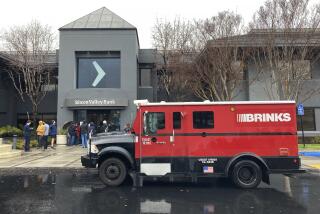A Summer of Sorts : Interns Seek Ways to Streamline County Government
Jaime Amezquita is up to his ears in paper work. In the past two months, the second-year USC graduate student has sorted through nearly 13,000 cubic feet of forms, records, architectural plans, maps and a variety of other documents that form the administrative nitty-gritty of Los Angeles County government.
Amezquita is one of 10 USC students chosen by the county to spend the summer as an intern, sifting through mountains of files and records in an effort to improve productivity and efficiency in the operation of county government.
The interns, all but one of whom are graduate students at the USC School of Public Administration, are devising ways to eliminate unnecessary forms and records and to consolidate documents that are alike.
They will present a list of recommendations to the Board of Supervisors when the internship ends late in August.
The program is the brainchild of Michael Jackson, senior analyst in the contracting and productivity section of the county’s Chief Administrative Office, and Arthur W. Gutenberg, vice chairman of the Los Angeles County Productivity Advisory Committee. The committee was established in April, 1981, to reduce the county’s administrative costs.
Last fall, Jackson and Gutenberg proposed the idea to USC Prof. Ross Clayton, dean of the School of Public Administration, who was at that time busy laying plans for a Productivity Research Center at the university. With Clayton’s and Gutenberg’s help, Jackson established the first countywide internship aimed at improving efficiency in county administration.
Amezquita and two other interns have been assigned the task of making an inventory of forms used in the Department of Facilities Management, which oversees the administration of the county’s buildings, information systems, engineering and mechanical operations. Once the inventory is completed, the three will recommend which forms are necessary and which ones should be stored or destroyed.
So far, the work has been slow and painstaking.
“It is tedious,” Terza A. West, one of the interns making the inventory, said. “After a while, everything starts looking the same.”
Amezquita said he spends about five hours every day completing a master list of all the different types of forms used for the thousands of administrative functions of county government. There are forms for purchasing cars and air conditioners and for evaluating the performance of employees. There are invoices for gasoline and oil purchases, and plans for buildings. There are deeds, surveys and appraisals. . . . The list goes on and on. Some of the documents are so old they are being considered for museum storage.
James D. Taylor, one of two interns at the county’s Department of Beaches and Harbors, said he and his partner, Don Offoegbu, recently stumbled upon a document which described the current site of Marina del Rey as a grassy marshland best known for good duck hunting.
“Think about how much paper work you generate from the time you are born,” Taylor said. “Well that’s one individual. The county takes over that (paper work) for each person it comes in contact with. We (the interns) have to make sure it’s not repetitive in any sense.”
And Los Angeles County government probably comes in contact with more people than any other similar entity in the U.S. It is the most populous county in the nation, and its $6-million annual budget exceeds those of 36 of the 50 states. There are more than 70,000 employees on the payroll.
Signs of Carelessness
“You don’t really begin to become aware of what falls under the auspices of the county until you start looking (at the paper work),” Taylor said. “The amount is overwhelming, and yet, because of that overwhelming amount, there develops a sort of carelessness. And what we’re trying to do is weed out everything we can at a cost savings.
“It’s not a real hot, sexy topic,” he added. “Bureaucracy is paper pushing, but so is life.”
Although it is too early to know exactly how much money will be saved, intern coordinators say they are confident the program will more than pay for itself.
“We expect a lot of savings to the county in space and cost and we expect there to be fewer forms,” Jack L. McNeil, administrative assistant for the Department of Facilities Management, said.
Ted L. Reed, assistant chief administrative officer, said even though the county hires professional consultants to improve efficiency, there are not enough of them to advise each of the 42 departments. The interns, who are paid $5 an hour, will help fill that gap, he said.
Employing qualified interns is an expedient way of getting around the budget cuts which hit the county after passage of Proposition 13 in 1978, said Marvin Rosenberg, chairman of the Productivity Advisory Committee.
“They (the county) can’t really go out and hire consultants if they have to reduce their budgets,” he said.
In addition to reducing costs, the internship is proving to be beneficial to the interns, most of whom plan to pursue carriers in public administration.
“They (county officials) are getting their money’s worth, and yet it’s been a tremendous learning experience for all of us,” Taylor said. “I’ve had a variety of internships and this one has given me a better experience than any of the others. I definitely think they value our input.”
Intern Clara Lyons said she values the program because it gives her more responsibility than her previous jobs and internships.
“The main goal is making the county more efficient,” she said. “I think we’re going to have some impact.”
More to Read
Start your day right
Sign up for Essential California for news, features and recommendations from the L.A. Times and beyond in your inbox six days a week.
You may occasionally receive promotional content from the Los Angeles Times.






